Setting Up HTML Editors
Popular Editors for HTML Development
Before writing HTML code, you need a suitable editor. Some widely used HTML editors include:
- VS Code: A powerful, lightweight editor with extensive extensions.
- Notepad++: A simple, fast alternative for Windows users.
- Sublime Text: Known for speed and a minimalist interface.
- Atom: A flexible, open-source editor.
Installation & Configuration
VS Code Installation (Recommended)
- Download VS Code from code.visualstudio.com.
- Install the software following the on-screen instructions.
- Open VS Code and install HTML-related extensions for enhanced development.
Essential Extensions for HTML Development
- Live Server: Allows real-time preview of changes.
- Prettier: Formats HTML code automatically.
- HTML Snippets: Provides quick access to common HTML structures.
Basic HTML Page Structure
An HTML document consists of essential elements to define a webpage structure.
<!DOCTYPE html>
<html>
<head>
<title>My First Webpage</title>
<meta charset="UTF-8">
<meta name="viewport" content="width=device-width, initial-scale=1.0">
</head>
<body>
<h1>Welcome to HTML</h1>
<p>This is my first HTML page.</p>
</body>
</html>
Explanation of Basic Elements
<!DOCTYPE html>: Declares the document as HTML5.<html>: The root element containing all webpage content.<head>: Holds metadata, title, and external resources.<body>: Contains the visible webpage content.
HTML Comments
Comments help developers add notes within HTML code without affecting its output.
Syntax
<!-- This is a comment -->
Importance of Comments
- Helps in code documentation.
- Makes debugging easier.
- Useful for temporarily disabling code sections.
This guide sets up your HTML development environment and introduces the basic structure of a webpage. Next, we’ll explore core HTML elements in detail.

